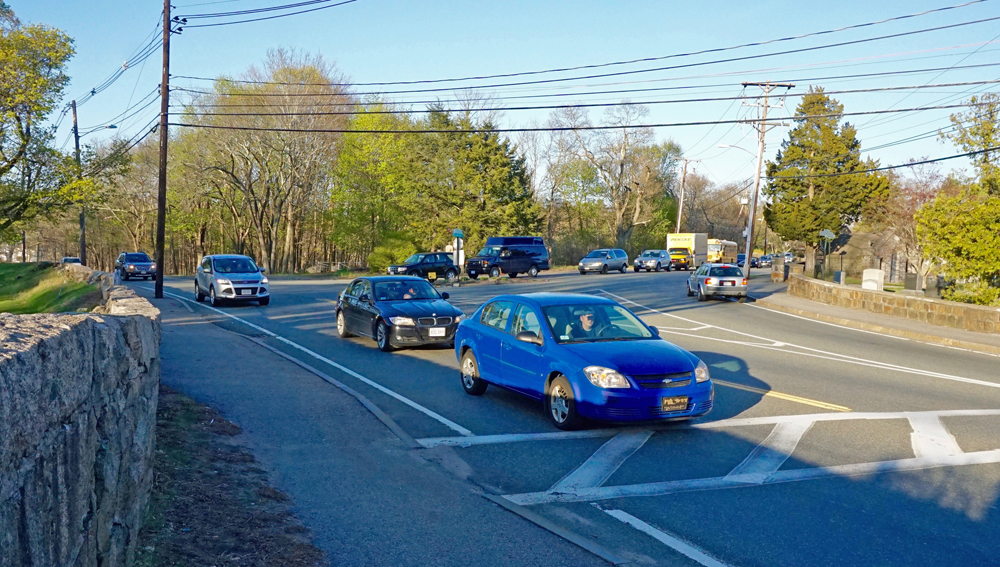Traffic light proposed for Randolph St. at Washington
By Mike Berger
The town is looking at options to alleviate congestion at Randolph/Washington St. (Michelle Stark photo)
The Boston Region Metropolitan Planning Organization (MPO) issued its top two recommendations this week for solving the traffic bottleneck at the Washington-Randolph Street intersection. Both recommendations involve the installation of a traffic signal that could be timed for on-peak and off-peak travel.
The first plan calls for installing a traffic light at the intersection and the second alternative involves a traffic light and the creation of a left-hand turning lane onto Randolph Street for those traveling southbound on Washington Street (heading toward the center). This alternative would also designate a right-hand turning lane for traffic headed northbound on Washington Street and right and left turning lanes at the end of Randolph Street.
The recommendations were presented at a public meeting held Tuesday night at the Canton Public Library that was attended by approximately 25 residents.
The Boston MPO, at no cost to the town, completed a study of the intersection that included collection of traffic volume data and accident research. The organization also hosted two public meetings to gather resident input in addition to Tuesday night’s meeting to discuss its recommendations.
Analysis of traffic counts found that nearly 1,000 cars headed in both directions of the intersection during morning and afternoon peak times. Fourteen accidents were recorded between 2010 and 2014, according to the Boston MPO study.
Both alternatives are estimated to cost between $200,000 and $500,000 and would require minimal street widening. The next step is up to the selectmen, who will decide whether to support either of the two recommendations before seeking design funds at the upcoming annual town meeting.
Selectman Kevin Feeney, who is also a member of the Blue Ribbon Traffic Committee, said after Tuesday’s meeting that it is too early to tell what the board will recommend. “We will get opinions from our professional staff and discuss,” he said.
Feeney did praise Town Planner Laura Smead for obtaining free services from the Boston MPO and for working to obtain several other planning grants for the town.
Although the Boston MPO presented its two preferred options, two other alternatives were briefly discussed — doing nothing and constructing a roundabout, which was loudly booed by members of the audience. Seth Asante of the Boston MPO told the audience that a roundabout at that location, from a planning perspective, would be wrong on many levels, starting with the fact that the town does not have enough land at the intersection for a roundabout. He added that if the town elected to leave the intersection in its present state, the traffic delays would continue to worsen each year.
Asante said both alternatives involving a traffic light would significantly reduce the waiting time for vehicles on Randolph Street. He added that in his opinion, the light would not impact traffic at the Washington-Chapman and Washington-Dedham Street intersections.
Resident Tony Braconi suggested a more measured approach in which the town first focused on adding more specific lane designations and reconfiguring the intersection with islands. “Let’s see how it works and then we could add the lights,” he said.
Braconi also criticized the study because it did not take into consideration the impact of traffic from Pecunit Street to Dedham Street, especially in the afternoon. He noted that selectmen had previously rejected his town meeting article in 2016 calling for a comprehensive, town-wide traffic study.
Feeney said the scope of work for the Boston MPO was specifically limited to the Randolph-Washington Street intersection. Smead added at the end of the meeting that a new master plan for the town could study the entire Washington Street traffic corridor.
In other traffic news, Smead invited residents as well as those who visit and work in Canton to participate in the town’s Complete Streets Stakeholder Input survey, available at www.arcg.is/1Svj0H. The survey has a mapping feature that enables respondents to identify current issues, future opportunities, or potential quick fixes for pedestrian accommodations, bicycle accommodations, and transit elements. Submissions are due by December 31.
Complete Streets is a state program that encourages municipalities to improve the safety and accessibility of its roadways for all travelers. In March, the Board of Selectmen approved its own Complete Streets policy, which was developed by Smead with input from the DPW and Planning Board. With the adoption of the policy, the town is now eligible for grant funding as well as technical assistance from the state Department of Transportation. For more information on the program, search for “Complete Streets” at www.massdot.state.ma.us.
Short URL: https://www.thecantoncitizen.com/?p=37697










